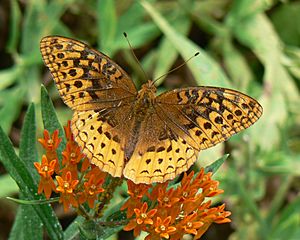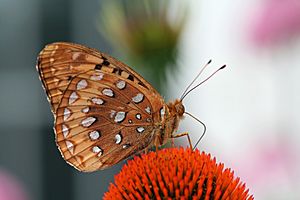Great spangled fritillary facts for kids
Quick facts for kids Great spangled fritillary |
|
|---|---|
 |
|
 |
|
| Conservation status | |
| Scientific classification | |
| Subspecies | |
|
See text |
The great spangled fritillary (Speyeria cybele) is a beautiful North American butterfly. It belongs to a group of butterflies called Nymphalidae. These butterflies are known for their bright orange wings with interesting black markings.
Contents
What Does the Great Spangled Fritillary Look Like?
This butterfly is quite large. Its wings can spread from about 62 to 88 millimeters (about 2.4 to 3.5 inches) wide. The top side of its wings is mostly orange. You will see five black dashes near the base of its front wings. There are also several black dashes on the base of its back wings. Along the edges of both wings, you will find two rows of black crescent shapes.
If you look at the underside of its front wings, they are yellowish-orange. They have similar black marks to the top side. You might also spot a few silver spots near the tip of the wing. The underside of the back wings is reddish-brown. It has shiny silver spots near the base and in the middle. A wide yellow band and silver triangles are easy to spot on these wings.
Female butterflies often have darker colors than males. Butterflies from the western parts of North America tend to be brighter orange. This butterfly looks a bit like other fritillaries. These include the Aphrodite fritillary (Speyeria aphrodite) and the Atlantis fritillary (Speyeria atlantis). You can tell the great spangled fritillary apart by a wide, light band on the underside of its back wing. Also, it has black dashes instead of black spots on the edges of its front wings.
Different Types: Subspecies
What are Subspecies?
Just like there are different breeds of dogs, there are different types of butterflies within a species. These are called subspecies. They are slightly different from each other, often because they live in different areas. The great spangled fritillary has several known subspecies. Some of these include:
- S. c. cybele
- S. c. leto
- S. c. novascotiae
Where Do Great Spangled Fritillaries Live?
This butterfly lives across a large part of North America. You can find it from southern Canada all the way down to northern California in the west. In the east, its range stretches to North Carolina. These butterflies love moist meadows and the edges of woodlands. These areas provide the right plants and conditions for them to thrive.
Life Cycle: What Do Caterpillars Eat?
Larval Host Plants
The great spangled fritillary starts its life as a tiny egg. When the egg hatches, a caterpillar comes out. This caterpillar needs specific plants to eat and grow. These plants are called "larval host plants." For the great spangled fritillary, the caterpillars mostly eat different kinds of violets.
Some of the violet species they are known to eat include:
- The native round-leaf violet (Viola rotundifolia)
- The arrow-leaf violet (Viola fimbriatula)
- The common blue violet (Viola sororia)
These violets provide all the food the caterpillars need to grow big and strong. After eating enough, the caterpillar will turn into a chrysalis. Then, it will transform into a beautiful adult butterfly.
Images for kids




